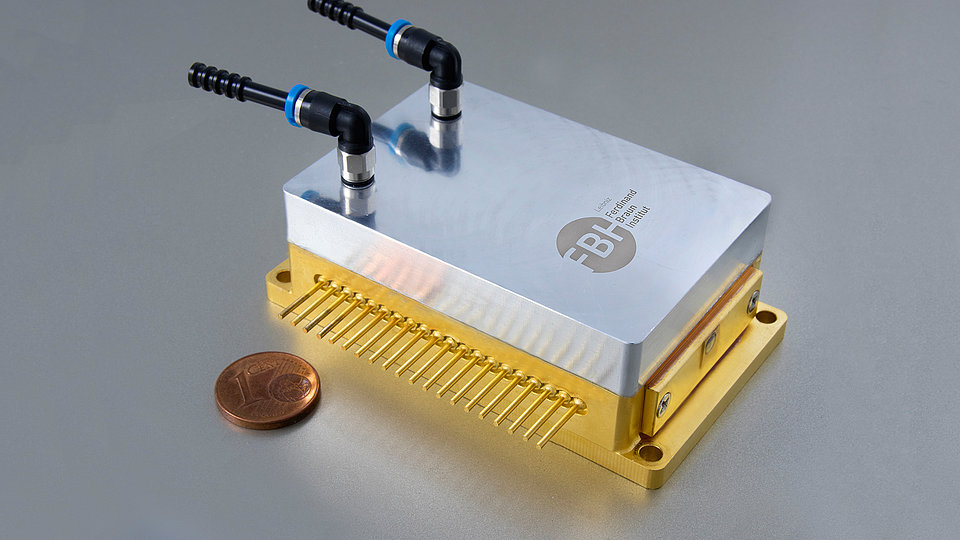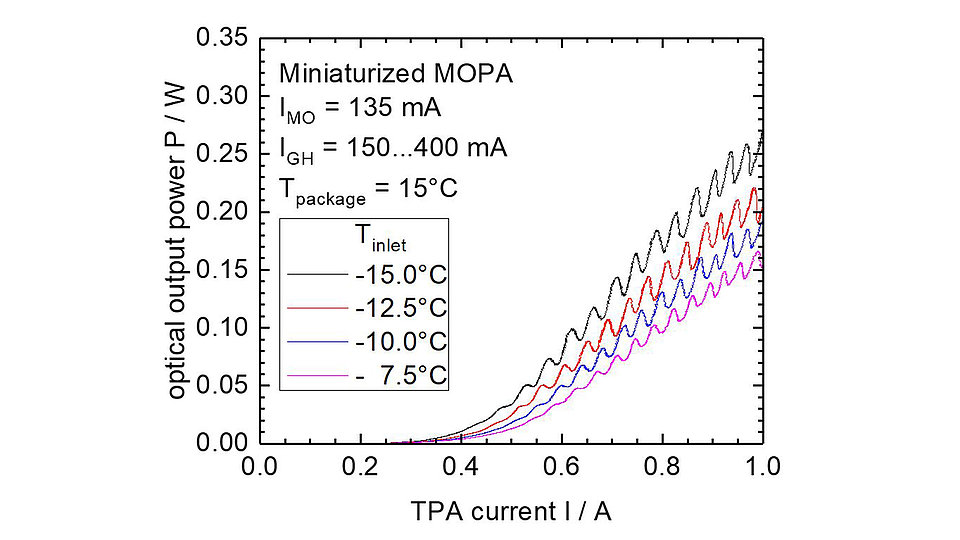To study quantum phenomena – compact diode laser source suited for cooling of beryllium ions
Ultracold ions, atoms and molecules are the basis for current studies of quantum phenomena. Typically, the required temperatures in the milli- and micro-Kelvin range are achieved using lasers. Laser cooling of beryllium ions requires laser light at 313 nm, which is usually generated via the second harmonic of light at 626 nm.
Recently, all-semiconductor laser systems at 626 nm have been demonstrated using two different concepts. One is based on an external cavity diode laser (ECDL) as master and an injection-locked slave laser with up to 140 mW [1] and the other uses a master-oscillator power-amplifier (MOPA) configuration with up to 200 mW output power [2]. The FBH has now succeeded in developing a miniaturized MOPA configuration while further increasing the optical output power. To reach a 626 nm emission wavelength with the AlGaInP/GaAs material system, the laser and amplifier chips need to be cooled to temperatures below zero. The FBH has met this challenge by developing a sealed package with a footprint of only 76 x 54 mm² (see Fig. 1). This allows the MOPA to be operated at sub-zero temperatures while preventing condensation and icing.
The MO uses an improved ridge-waveguide laser with internal Bragg grating (DBR-RWL) [3]. Grating heaters were then added, which allow to tune the wavelength independently of the chip temperature. Furthermore, a new generation of tapered amplifiers were employed as PA, featuring a higher internal efficiency and hence higher output power. Both MO and PA were integrated into the butterfly package together with micro-optics for coupling and beam shaping as well a prototype of a miniaturized optical isolator based on CdMnTe [4]. The isolator features an outer diameter of 5.1 mm and a clear aperture of 0.8 mm, a transmission of 40 % and an isolation of 25 dB. The resulting MOPA emits up to 250 mW in a single longitudinal mode with a side-mode suppression of 30 dB. This emission is also almost diffraction limited with a beam propagation ratio M² < 2 [5]. These features make this laser source ideally suited to efficiently generate light at 313 nm using frequency doubling. Moreover, it enables to significantly reduce the size of future laser cooling systems for beryllium ions.
The manufacturing of the MOPA chips was funded by the German Federal Ministry of Education and Research (BMBF) within the FinDLiNG project under the project reference 13N13954.
Publications
[1] H. Ball, M. W. Lee, S. D. Gensemer, and M. J. Biercuk, “A high-power 626 nm diode laser system for beryllium ion trapping”, Rev. Sci. Instrum., vol. 84, Art. no. 063107 (2013).
[2] N. Ohmae and H. Katori, “626-nm single-frequency semiconductor laser system operated near room temperature for mW-level second-harmonic generation at 313 nm”, Rev. Sci. Inst., vol. 90, Art. no. 063201 (2019).
[3] G. Blume, O. Nedow, D. Feise, J. Pohl, and K. Paschke, “Monolithic 626 nm single-mode AlGaInP DBR diode laser”, Optics Express, vol. 21, no. 18, pp. 21677-21684 (2013).
[4] G. Blume, D. Jedrzejczyk, J. Pohl, D. Feise, A. Sahm, N. Werner, C. Nölleke, P. Leisching, K. Paschke "633-nm single-mode master-oscillator power-amplifier module", Proc. SPIE 10528, 105280D (2018). Many thanks to Toptica Photonics AG for providing the isolator parts.
[5] G. Blume, M. Drees, J. Pohl, D. Feise, A. Sahm, K. Paschke "Miniaturized, electrically-tunable master-oscillator power-amplifier in sealed package for operation up to 250 mW at 626 nm", submitted to IEEE Photonics Technology Letters 2021-06-17.

